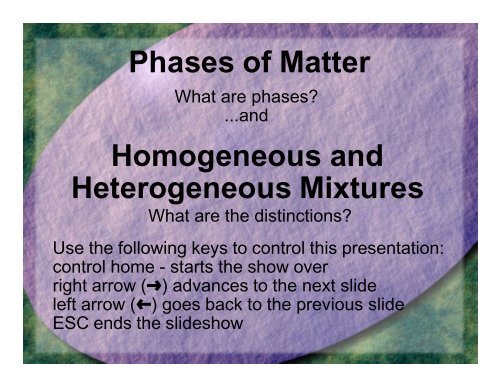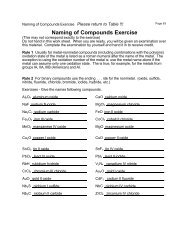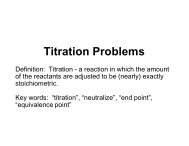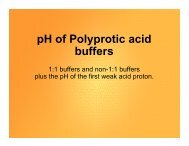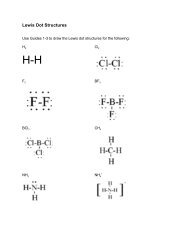Homogeneous and Heterogeneous Mixtures
Homogeneous and Heterogeneous Mixtures
Homogeneous and Heterogeneous Mixtures
- No tags were found...
You also want an ePaper? Increase the reach of your titles
YUMPU automatically turns print PDFs into web optimized ePapers that Google loves.
Phases of MatterWhat are phases?...<strong>and</strong><strong>Homogeneous</strong> <strong>and</strong><strong>Heterogeneous</strong> <strong>Mixtures</strong>What are the distinctions?Use the following keys to control this presentation:control home - starts the show overright arrow (º) advances to the next slideleft arrow (») goes back to the previous slideESC ends the slideshow
PhasesMost people are familiar with the three majorphases, solid, liquid <strong>and</strong> gas. They may bedistinguished by two properties
PhasesThese two properties are whether they conform! to the shape of the container they are in <strong>and</strong>! to the total volume of the container.
PhasesThese two properties are whether they conform! to the shape of the container they are in <strong>and</strong>! to the total volume of the container.The table below summarizes this:phasesolidliquidgasshaperetains shapeconformsconformsvolumeretains volumeretains volumeconforms
Phasesphasesolidliquidgasshaperetains shapeconformsconformsvolumeretains volumeretains volumeconformsSolids retain shape <strong>and</strong> volume because theiratoms <strong>and</strong> molecules are in a regular 3D array.
Phasesphasesolidliquidgasshaperetains shapeconformsconformsvolumeretains volumeretains volumeconformsAny phase must at least stay inside thecontainer, but a liquid also retains its volume.The reason is that the molecules stay in contactwith each other most of the time. As the next 2Dfigure illustrates.
Phasesphasesolidliquidgasshaperetains shapeconformsconformsvolumeretains volumeretains volumeconformsThe arrows are meant toconvey that thesemolecules are constantlyrolling around each other,yet staying mostly incontact.
Phasesphasesolidliquidgasshaperetains shapeconformsconformsvolumeretains volumeretains volumeconformsTherefore, the liquidcannot retain its shape.Due to the restraint of theattractions, it cannotchange its volume.
Phasesphasesolidliquidgasshaperetains shapeconformsconformsvolumeretains volumeretains volumeconformsGas molecule do not interact much with eachother <strong>and</strong> move unrestrained:
PhasesThere may be several phases present at once.There can also be several solid phases of thesame compound. This latter fact is due to thepossibility that different geometrical arrangementcan be created in a 3D array.These considerations will be taken up in thesection “Phase Diagrams”
<strong>Homogeneous</strong> <strong>and</strong> <strong>Heterogeneous</strong> <strong>Mixtures</strong>Generally mixtures of substances can be classifiedeither as homogeneous or heterogeneous. Thefollowing is a functional definition of these
<strong>Homogeneous</strong> <strong>and</strong> <strong>Heterogeneous</strong> <strong>Mixtures</strong>Generally mixtures of substances can be classifiedeither as homogeneous or heterogeneous. Thefollowing is a functional definition of these! <strong>Homogeneous</strong> mixtures are uniform thoughouton a scale corresponding to visible light (400 nm orgreater) . Thus, homogeneous mixtures consist ofa single phase.
<strong>Homogeneous</strong> <strong>and</strong> <strong>Heterogeneous</strong> <strong>Mixtures</strong>Generally mixtures of substances can be classifiedeither as homogeneous or heterogeneous. Thefollowing is a functional definition of these! <strong>Homogeneous</strong> mixtures are uniform thoughouton a scale corresponding to visible light (400 nm orgreater) . Thus, homogeneous mixtures consist ofa single phase.! <strong>Heterogeneous</strong> mixtures are not uniformthroughout. Thus, heterogeneous mixturesgenerally consist of more than one distinct phase.
<strong>Homogeneous</strong> <strong>and</strong> <strong>Heterogeneous</strong> <strong>Mixtures</strong>Generally mixtures of substances can be classifiedeither as homogeneous or heterogeneous. Thefollowing is a functional definition of these! <strong>Homogeneous</strong> mixtures are uniform thoughouton a scale corresponding to visible light (400 nm orgreater) . Thus, homogeneous mixtures consist ofa single phase.! <strong>Heterogeneous</strong> mixtures are not uniformthroughout. Thus, heterogeneous mixturesgenerally consist of more than one distinct phase.The size dividing line between these two is a bitrough with an intermediate types referred to ascolloids.
This is the EndUse the following keys if you do not want to exit.control home - starts the show overright arrow (º) advances to the next slideleft arrow (») goes back to the previous slide


